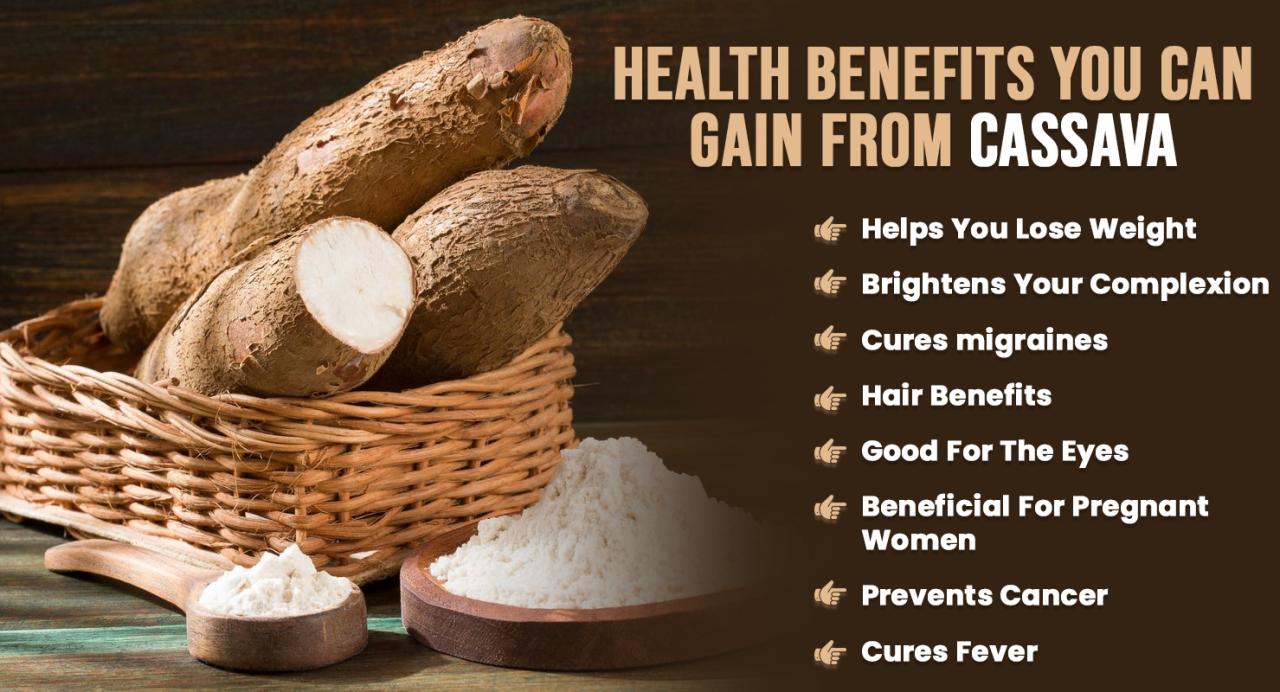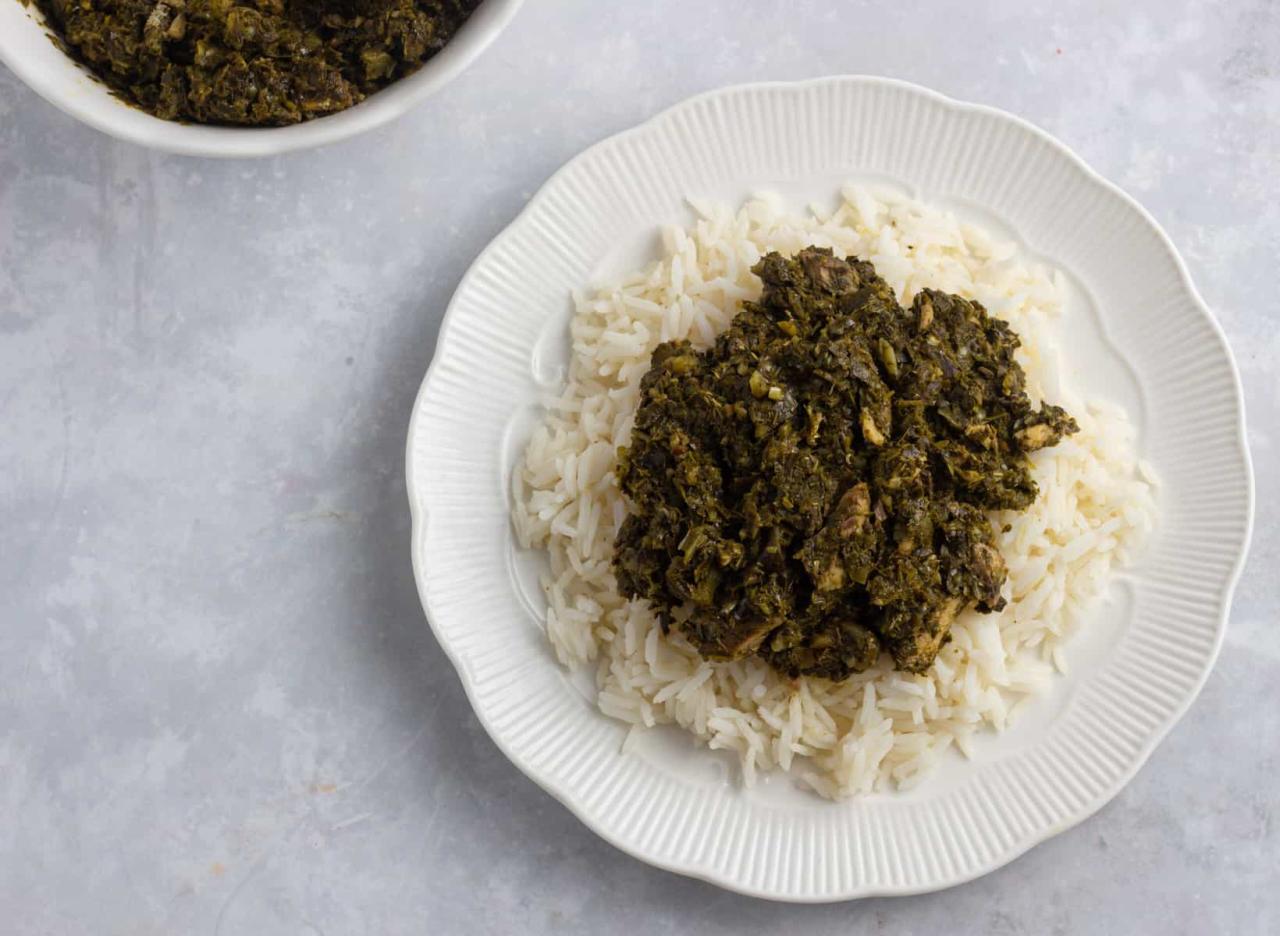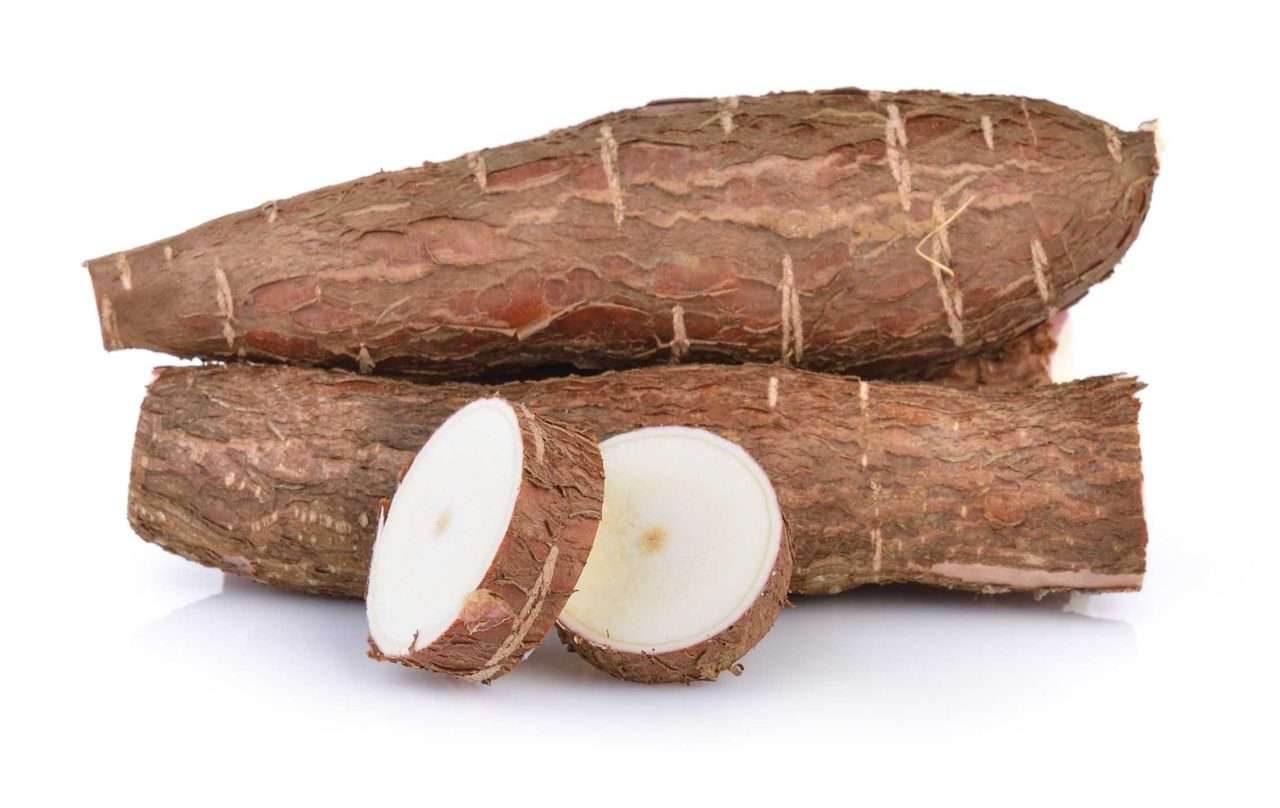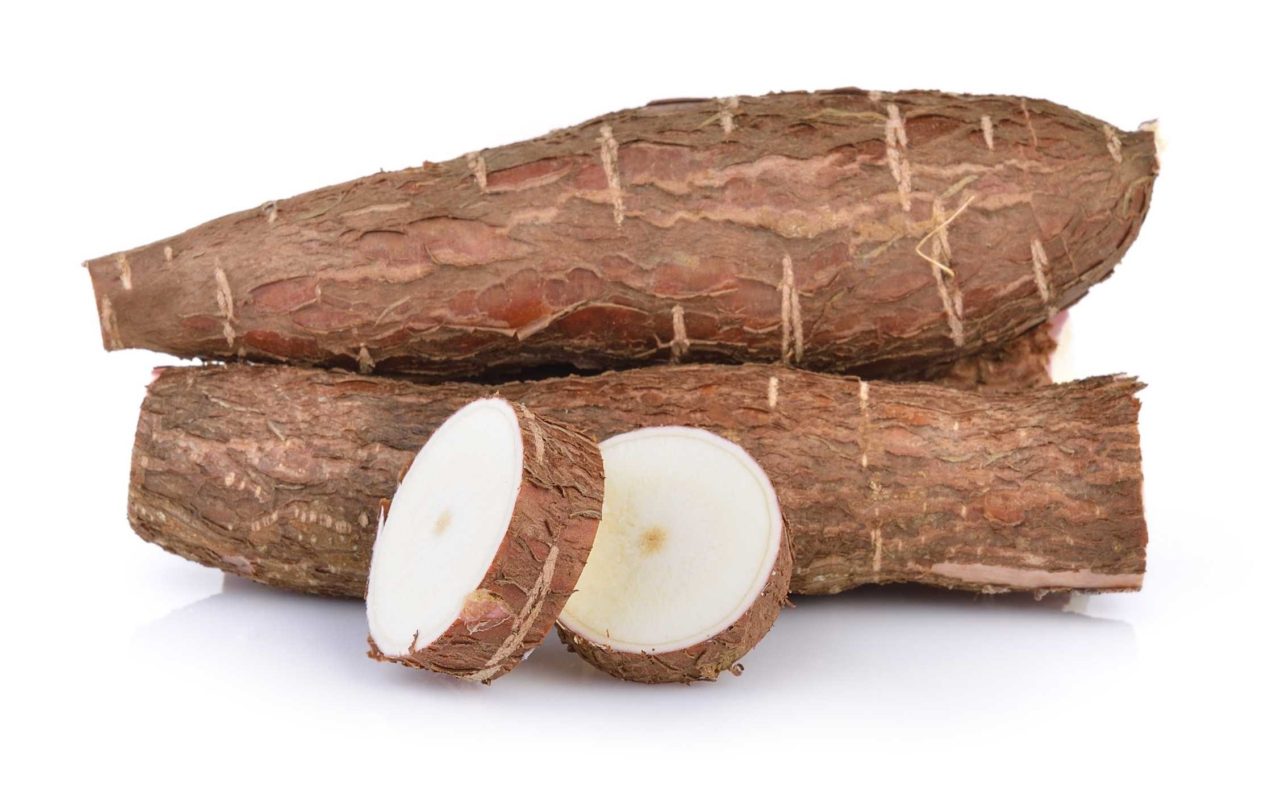Cassava Leaf Benefits: How to Grow and Utilize This Versatile Plant for Your Health, delves into the world of this remarkable plant, exploring its nutritional value, health benefits, and culinary uses. From its roots to its leaves, cassava offers a treasure trove of possibilities for both sustenance and well-being.
This comprehensive guide will equip you with the knowledge to cultivate your own cassava plants, harness its potential in the kitchen, and reap its numerous health advantages.
Cassava, a starchy root vegetable native to South America, has long been a staple food in many cultures. Its leaves, often overlooked, are a nutritional powerhouse packed with vitamins, minerals, and antioxidants. Beyond its culinary applications, cassava leaves have been revered for their medicinal properties in traditional medicine systems worldwide.
This article will explore the diverse benefits of cassava leaves, from boosting immunity and managing blood sugar levels to promoting healthy skin and hair. We will also delve into the art of cultivating this versatile plant, providing step-by-step instructions for growing and harvesting your own cassava.
Introduction to Cassava Leaf Benefits
Cassava, also known as yuca or manioc, is a starchy root vegetable that plays a crucial role in the diets of millions worldwide, particularly in tropical and subtropical regions. It’s a staple food in many African, Latin American, and Asian countries, and its leaves, often overlooked, are a nutritional powerhouse with various health benefits.Cassava leaves are a rich source of essential nutrients, vitamins, and minerals.
They are particularly high in vitamin A, vitamin C, vitamin K, and iron, all of which contribute to overall health and well-being. They also contain significant amounts of protein, fiber, and antioxidants, making them a valuable addition to any diet.
Nutritional Profile of Cassava Leaves
Cassava leaves are a treasure trove of essential nutrients, offering a diverse range of vitamins, minerals, and antioxidants that contribute to various aspects of health.
- Vitamins:Cassava leaves are particularly rich in vitamin A, vitamin C, and vitamin K. Vitamin A is crucial for maintaining healthy vision, skin, and immune function. Vitamin C acts as a powerful antioxidant, protecting cells from damage and boosting immunity.
Vitamin K is essential for blood clotting and bone health.
- Minerals:Cassava leaves are a good source of iron, calcium, and potassium. Iron is vital for red blood cell production and oxygen transport. Calcium is essential for strong bones and teeth. Potassium helps regulate blood pressure and supports muscle function.
- Antioxidants:Cassava leaves contain various antioxidants, including flavonoids and phenolic compounds. These antioxidants help combat free radicals, protecting cells from damage and reducing the risk of chronic diseases.
Versatility of Cassava Leaves as a Food Source and Medicinal Ingredient
Cassava leaves have a long history of use as a food source and medicinal ingredient in various cultures. Their versatility makes them a valuable addition to both culinary and therapeutic applications.
- Culinary Uses:Cassava leaves are commonly used in various cuisines, particularly in Africa, Latin America, and Southeast Asia. They are often boiled, steamed, or stir-fried and added to soups, stews, and salads. Cassava leaves can also be used to make traditional dishes like ” Afang soup” in Nigeria and ” Lula” in Brazil.
- Medicinal Properties:Cassava leaves have been traditionally used for their medicinal properties in various cultures. They are believed to possess anti-inflammatory, antioxidant, and antimicrobial properties, which may help alleviate various health conditions. Some studies suggest that cassava leaves may have potential benefits for treating diabetes, anemia, and certain types of cancer.
Health Benefits of Cassava Leaves

Cassava leaves, often overlooked as a food source, offer a wealth of nutritional and medicinal benefits. They are packed with vitamins, minerals, and antioxidants, making them a valuable addition to a healthy diet.
Boosting the Immune System
Cassava leaves are rich in vitamin C, a potent antioxidant that plays a crucial role in bolstering the immune system. Vitamin C helps stimulate the production of white blood cells, which are essential for fighting off infections. The leaves also contain other immune-boosting nutrients like vitamin A and zinc.
Managing Blood Sugar Levels
Cassava leaves have shown promise in helping manage blood sugar levels, making them a potential aid for individuals with diabetes. Research suggests that compounds present in the leaves may help regulate insulin sensitivity and glucose metabolism.
Healthy Digestion
Cassava leaves are a good source of dietary fiber, which is essential for maintaining a healthy digestive system. Fiber promotes regular bowel movements, prevents constipation, and supports the growth of beneficial bacteria in the gut.
Skin and Hair Health
Cassava leaves are rich in antioxidants, which can protect the skin from damage caused by free radicals. They also contain vitamins A and E, known for their skin-nourishing properties. The leaves can be used topically to promote skin health or consumed to improve overall skin appearance.
Heart Health
Cassava leaves contain potassium, a mineral that plays a vital role in maintaining healthy blood pressure. They are also a good source of fiber, which can help lower cholesterol levels. These factors contribute to the potential of cassava leaves in promoting heart health.
Cultivating Cassava: Cassava Leaf Benefits: How To Grow And Utilize This Versatile Plant For Your Health
Cassava, a starchy root vegetable, is a staple food in many tropical and subtropical regions. Its leaves, however, are also a nutritious and versatile ingredient, rich in vitamins, minerals, and antioxidants. Growing your own cassava plants allows you to reap the benefits of both the roots and the leaves.
Optimal Growing Conditions
Cassava thrives in warm climates with ample sunlight. It prefers well-drained soil with a pH range of 5.5 to 6.5. The plant requires consistent moisture but can tolerate periods of drought.
Planting Cassava Cuttings or Seeds
Cassava is typically propagated through cuttings, although seeds can also be used.
- Using Cuttings:Select healthy stems from mature cassava plants, about 12-18 inches long. Remove the leaves from the bottom 6 inches of the stem. Plant the cuttings horizontally in the soil, ensuring that the cut end is buried. Keep the soil moist until the cuttings root.
- Using Seeds:Cassava seeds are small and can be sown directly into the soil. Plant them about 1 inch deep and 12 inches apart. Water the seeds regularly and keep the soil moist.
Essential Care Practices
- Fertilization:Cassava benefits from regular fertilization, particularly with nitrogen and potassium. Apply fertilizer every 2-3 months during the growing season.
- Pest Control:Cassava is susceptible to various pests, including mealybugs, whiteflies, and aphids. Use natural pest control methods such as insecticidal soap or neem oil.
- Disease Management:Cassava is prone to diseases like cassava mosaic disease and bacterial blight. Choose disease-resistant varieties and practice good sanitation to minimize disease risks.
Harvesting Cassava Leaves and Roots
- Leaves:Harvest cassava leaves when they are young and tender. Pick the leaves from the top of the plant, leaving the lower leaves intact. The leaves can be used fresh or dried for later use.
- Roots:Cassava roots are typically harvested 9-12 months after planting. Dig up the roots carefully, avoiding damage. The roots can be eaten fresh, boiled, fried, or processed into flour.
Cassava Varieties
Variety |
Characteristics |
|---|---|
MCol 22 |
High yield, disease-resistant |
TMS 30572 |
High starch content, drought-tolerant |
TMS 60444 |
Early maturing, high yield |
TMS 96/0021 |
Resistant to cassava mosaic disease, high yield |
Culinary Uses of Cassava Leaves
Cassava leaves, a nutritious and versatile ingredient, are a staple in many cuisines worldwide, particularly in tropical and subtropical regions. Their unique flavor and nutritional profile make them a valuable addition to various dishes, ranging from soups and stews to salads and stir-fries.
Cassava Leaf Recipes, Cassava Leaf Benefits: How to Grow and Utilize This Versatile Plant for Your Health
Cassava leaves are a popular ingredient in a wide range of dishes, showcasing their versatility and adaptability to different culinary traditions. Here are some examples of recipes featuring cassava leaves:
- Egusi Soup (Nigeria):This rich and flavorful soup, a staple in Nigerian cuisine, is often made with ground melon seeds, vegetables, and meat or fish. Cassava leaves are frequently added to the soup for their unique taste and nutritional value.
- Lula (Brazil):Lula is a traditional Brazilian dish consisting of minced pork or beef, often combined with cassava leaves, onions, and spices. It is typically served with rice and beans.
- Gumbo (United States):Cassava leaves can be incorporated into gumbo, a thick and flavorful stew originating from the Southern United States. The leaves add a distinct taste and texture to the dish.
- Sinangag (Philippines):Sinangag, a popular Filipino dish of garlic fried rice, can be enhanced with the addition of chopped cassava leaves, adding a unique flavor and nutritional boost.
- Cassava Leaf Salad (Various Regions):Cassava leaves can be used to create a refreshing and nutritious salad. They are often combined with other leafy greens, vegetables, and dressings.
Preparing and Cooking Cassava Leaves
Proper preparation and cooking techniques are crucial for retaining the nutritional value and enhancing the flavor of cassava leaves. Here are some tips:
- Blanching:Blanching cassava leaves in boiling water for a few minutes helps remove any bitterness and softens the leaves. This step is especially recommended for young leaves.
- Cooking Time:Cassava leaves should be cooked until tender, which typically takes about 10-15 minutes. Overcooking can lead to a mushy texture.
- Flavor Enhancement:Adding spices, herbs, and other ingredients like onions, garlic, and tomatoes can enhance the flavor of cassava leaf dishes.
- Storage:Fresh cassava leaves can be stored in the refrigerator for up to 3 days. Alternatively, they can be frozen for longer storage.
Cultural Significance of Cassava Leaf Dishes
Cassava leaf dishes hold cultural significance in many regions, often reflecting the history, traditions, and culinary practices of the people.
- Africa:Cassava leaves are a staple ingredient in many African cuisines, particularly in West Africa. Dishes like Egusi soup and Afang soup are considered national treasures and are often served during special occasions and celebrations.
- South America:In Brazil, cassava leaves are widely used in dishes like Lula and Maniçoba, which are integral parts of the country’s culinary heritage. These dishes are often passed down through generations, representing a connection to cultural roots.
- Asia:Cassava leaves are also incorporated into Asian cuisine, particularly in Southeast Asia. Dishes like Sinangag and La Paz Batchoy are popular examples of how cassava leaves are used in Filipino and Chinese cuisine, respectively.
Cassava Leaves in Traditional Medicine

Cassava leaves, a readily available and nutritious food source, have long been valued in traditional medicine systems across the globe. From the Amazon rainforest to the African savanna, generations have utilized the leaves’ diverse properties to address a range of ailments.
Historical and Cultural Use of Cassava Leaves in Traditional Medicine
Cassava leaves have been a mainstay in traditional medicine for centuries, with their use deeply rooted in the cultural practices of various indigenous communities. In the Amazon, the indigenous people of the region have long relied on cassava leaves for their medicinal properties.
Just as cassava leaves offer a wealth of nutritional benefits and culinary versatility, exploring the unique flavors of other plants can elevate your cooking experience. Kaffir lime leaves, for example, bring a distinct citrusy aroma and a touch of zest to Thai and Southeast Asian cuisine.
Kaffir Lime Leaf Magic: Transform Your Cooking with This Unique Herb provides a fascinating insight into this aromatic herb, highlighting its versatility in dishes ranging from curries to soups. Like cassava leaves, kaffir lime leaves offer a unique flavor profile that can add depth and complexity to your meals.
They used the leaves to treat a wide range of ailments, including skin infections, fevers, and digestive issues. Similarly, in Africa, cassava leaves have been used in traditional medicine for generations. They are often used to treat malaria, diarrhea, and other common ailments.
The leaves are also used to promote wound healing and relieve pain.
Cassava leaves, a nutritious and versatile ingredient, offer a wealth of health benefits. From boosting immunity to aiding in weight management, this tropical plant is a valuable addition to any diet. While cultivating cassava for its leaves requires specific knowledge, incorporating other elegant plants like papyrus can enhance your garden’s aesthetic appeal.
For tips on achieving garden elegance with papyrus plants, explore this informative guide: How to Achieve Garden Elegance with Papyrus Plant: Essential Care and Growing Tips. By combining the practicality of cassava with the visual charm of papyrus, you can create a thriving and visually stunning garden that nourishes both body and soul.
Medicinal Properties Attributed to Cassava Leaves
Cassava leaves are rich in essential nutrients and possess a wide range of medicinal properties, including:
- Antioxidant Properties:Cassava leaves are rich in antioxidants, which help protect the body against damage caused by free radicals. These antioxidants can help prevent chronic diseases such as cancer, heart disease, and Alzheimer’s disease.
- Anti-Inflammatory Properties:Cassava leaves contain compounds with anti-inflammatory properties, which can help reduce inflammation throughout the body. This can be beneficial for treating a range of conditions, including arthritis, asthma, and inflammatory bowel disease.
- Anti-Diabetic Properties:Cassava leaves have been shown to help regulate blood sugar levels. They may be beneficial for people with type 2 diabetes.
- Anti-Microbial Properties:Cassava leaves have anti-microbial properties, which can help fight off infections. They may be effective in treating bacterial and fungal infections.
Traditional Remedies Using Cassava Leaves
Traditional medicine systems utilize cassava leaves in a variety of ways, including:
- Decoctions:Cassava leaves are often boiled in water to create a decoction, which can be consumed or applied topically. Decoctions are used to treat a range of ailments, including fevers, diarrhea, and skin infections.
- Poultices:Crushed cassava leaves can be applied to wounds and sores as a poultice. Poultices are used to promote wound healing and reduce inflammation.
- Juices:Cassava leaves can be juiced and consumed to benefit from their nutritional and medicinal properties. The juice is often used to treat digestive issues and boost the immune system.
Comparison and Contrast of Cassava Leaf Uses in Different Traditional Medicine Systems
Cassava leaves are used in various traditional medicine systems, with some differences in their applications.
- Amazonian Traditional Medicine:In the Amazon, cassava leaves are often used to treat skin infections, fevers, and digestive issues. They are also used to promote wound healing and relieve pain.
- African Traditional Medicine:In Africa, cassava leaves are widely used to treat malaria, diarrhea, and other common ailments. They are also used to promote wound healing and relieve pain.
- Asian Traditional Medicine:In some Asian countries, cassava leaves are used to treat diabetes, high blood pressure, and other chronic diseases.
Conclusion
Cassava leaves offer a treasure trove of health benefits, making them a valuable addition to any diet. Their nutritional richness, particularly in vitamins, minerals, and antioxidants, contributes to overall well-being and disease prevention.
Cassava Leaves: A Nutritional Powerhouse
Cassava leaves are a nutritional powerhouse, packed with essential vitamins and minerals.
- They are an excellent source of vitamin A, crucial for healthy vision, immune function, and cell growth.
- They are rich in vitamin C, a powerful antioxidant that boosts the immune system and protects against cell damage.
- Cassava leaves also contain vitamin K, essential for blood clotting and bone health.
- They are a good source of iron, crucial for red blood cell production and oxygen transport.
- They are also rich in calcium, which plays a vital role in bone health and muscle function.
Final Summary

Cassava leaves, a humble yet potent ingredient, offer a unique blend of nutritional and medicinal benefits. From enriching your diet with essential vitamins and minerals to supporting your overall well-being, incorporating cassava leaves into your lifestyle can be a rewarding experience.
By embracing this versatile plant, you can tap into a rich cultural heritage, enjoy delicious culinary creations, and unlock the potential for a healthier, more vibrant life.
Expert Answers
Are cassava leaves safe to eat?
Yes, cassava leaves are safe to eat when properly prepared. However, it’s important to note that raw cassava leaves contain a substance called linamarin, which can be toxic if not processed correctly. Cooking cassava leaves thoroughly removes this toxin, making them safe for consumption.
How often can I eat cassava leaves?
There is no specific recommendation for how often to eat cassava leaves. It’s generally safe to consume them in moderation as part of a balanced diet. However, it’s always advisable to consult with a healthcare professional for personalized dietary advice.
What are the potential side effects of consuming cassava leaves?
Cassava leaves are generally safe for consumption, but some individuals may experience mild side effects like bloating, gas, or diarrhea. If you experience any adverse reactions, it’s best to stop consuming cassava leaves and consult with a doctor.
